A) D2
B) D3
C) D4
D) D5
Correct Answer

verified
Correct Answer
verified
Multiple Choice
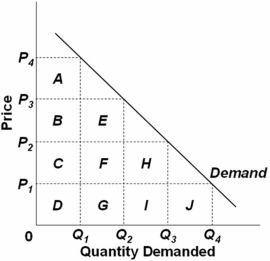 Refer to the graph above and assume that the areas of the boxes are the same.Consider a situation where price decreases from P2 to P1.In this price range,demand is relatively:
Refer to the graph above and assume that the areas of the boxes are the same.Consider a situation where price decreases from P2 to P1.In this price range,demand is relatively:
A) inelastic because the loss in total revenue (areas D + G + I + J) is greater than the gain in total revenue (areas C + F + H) .
B) elastic because the loss in total revenue (areas C + F + H) is greater than the gain in total revenue (area J) .
C) elastic because the loss in total revenue (area J) is less than the gain in total revenue (areas C + F + H) .
D) inelastic because the gain in total revenue (area J) is less than the loss in total revenue (areas C + F + H) .
Correct Answer

verified
Correct Answer
verified
Multiple Choice
Sony is considering a 10 percent price reduction on its LCD television sets.If the demand for sets in this price range is inelastic:
A) revenues from LCD sets will remain constant.
B) revenues from LCD sets will decrease.
C) revenues from LCD sets will increase.
D) the number of LCD sets sold will decrease.
Correct Answer

verified
Correct Answer
verified
Multiple Choice
Inelastic demand displays:
A) little price stretch.
B) little quantity stretch.
C) considerable price stretch.
D) considerable quantity stretch.
Correct Answer

verified
Correct Answer
verified
Multiple Choice
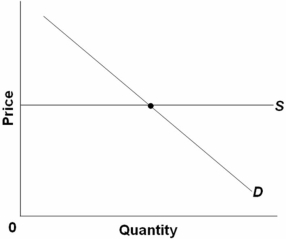 Refer to the graph above.Which statement is correct?
Refer to the graph above.Which statement is correct?
A) The demand curve is perfectly elastic.
B) The demand curve is perfectly inelastic.
C) The supply curve is perfectly elastic.
D) The supply curve is perfectly inelastic.
Correct Answer

verified
Correct Answer
verified
Multiple Choice
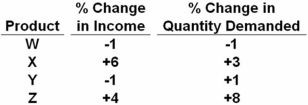 Refer to the table above.Which product is an inferior good?
Refer to the table above.Which product is an inferior good?
A) Product W
B) Product X
C) Product Y
D) Product Z
Correct Answer

verified
Correct Answer
verified
Multiple Choice
State government wants to increase the taxes on cigarettes to increase tax revenue.This tax would only be effective in raising new tax revenues if the price elasticity of demand is:
A) unity.
B) elastic.
C) inelastic.
D) perfectly elastic.
Correct Answer

verified
Correct Answer
verified
Multiple Choice
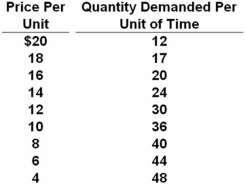 Refer to the above data.Over which price range is the price elasticity of demand inelastic?
Refer to the above data.Over which price range is the price elasticity of demand inelastic?
A) $20-$18
B) $18-$16
C) $12-$10
D) $10-$8
Correct Answer

verified
Correct Answer
verified
Multiple Choice
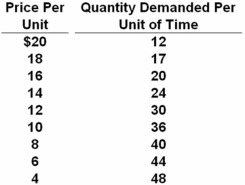 Refer to the above data.Over which price range is the price elasticity of demand unitary?
Refer to the above data.Over which price range is the price elasticity of demand unitary?
A) $16-$14
B) $14-$12
C) $12-$10
D) $10-$8
Over the price range $12-$10,the change in quantity is (36 - 30) /(36 + 30) = 0.091 and the change in price is (12 - 10) /(12 + 10) = 0.091.Thus,price elasticity is 0.091/0.091 = 1.0.
Correct Answer

verified
Correct Answer
verified
Multiple Choice
Airlines charge business travelers more than leisure travelers because there is a more:
A) elastic supply of business travel.
B) inelastic supply of business travel.
C) elastic demand for business travel.
D) inelastic demand for business travel.
Correct Answer

verified
Correct Answer
verified
Multiple Choice
Demand can be said to be inelastic when:
A) an increase in price results in a reduction in total revenue.
B) a reduction in price results in an increase in total revenue.
C) a reduction in price results in a decrease in total revenue.
D) the elasticity coefficient exceeds one.
Correct Answer

verified
Correct Answer
verified
Multiple Choice
The supply curve for cars will be more elastic the:
A) greater the quantity demanded.
B) longer the time interval considered.
C) greater the decline in input prices.
D) less able producers are to make other goods.
Correct Answer

verified
Correct Answer
verified
Multiple Choice
If an increase in the supply of a product results in a decrease in the price,but no change in the actual quantity of the product exchanged,then the:
A) price elasticity of supply is zero.
B) price elasticity of supply is infinite.
C) price elasticity of demand is unitary.
D) price elasticity of demand is zero.
Correct Answer

verified
Correct Answer
verified
True/False
The demand for cocaine is believed to be relatively elastic among addicts.
Correct Answer

verified
Correct Answer
verified
Multiple Choice
If a business decreased the price of its product from $10 to $9 when demand was price inelastic,then total revenues would:
A) decrease.
B) increase.
C) remain unchanged.
D) be perfectly inelastic.
Correct Answer

verified
Correct Answer
verified
Multiple Choice
At a price of $4 per unit,Gadgets Inc.is willing to supply 20,000 gadgets,while United Gadgets is willing to supply 10,000 gadgets.If the price were to rise to $8 per unit,their respective quantities supplied would rise to 45,000 and 25,000.If these are the only two firms supplying gadgets,what is the elasticity of supply in the market for gadgets?
A) 1.2
B) 1.0
C) 0.833
D) 0.80
The change in quantity supplied is (70,000 - 30,000) /(70,000 + 30,000) = 0.40 and the change in price is (8 - 4) /(8 + 4) = 0.333.Thus,elasticity is 0.40/.0333 = 1.2.
Correct Answer

verified
Correct Answer
verified
True/False
In the price range where demand is elastic,an increase in price will result in a gain in total revenue.
Correct Answer

verified
Correct Answer
verified
Multiple Choice
Changes in demand have a large effect on the price of gold because the:
A) supply of gold is relatively elastic.
B) supply of gold is relatively inelastic.
C) demand for gold is relatively elastic.
D) demand for gold is relatively inelastic.
Correct Answer

verified
Correct Answer
verified
Multiple Choice
Suppose that when the price of good X changes from $5 to $10,the demand for good Y changes from 110 to 100,then the cross-elasticity of demand is:
A) -0.09 and the goods are complements.
B) 1.44 and the goods are complements.
C) 1.44 and the goods are substitutes.
D) -0.143 and the goods are complements.
The percent change in quantity of Y is (100 - 110) /(100 + 110) = -0.0476 and the percent change in the price of X is (10 - 5) /(10 + 5) = 0.333.Thus the cross-price-elasticity is-0.0476/0.333 = -0.143.
Correct Answer

verified
Correct Answer
verified
Multiple Choice
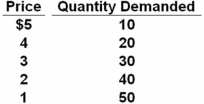 Refer to the table above.Starting at a $1 price,at what price range does demand become elastic?
Refer to the table above.Starting at a $1 price,at what price range does demand become elastic?
A) $1-2
B) $2-3
C) $3-4
D) $4-5
At $3-4,the change in quantity is (20 - 30) /(20 + 30) = 0.20 and the change in price is (3 - 4) /(3 + 4) = 0.143.Thus,elasticity is 1.40,which is elastic.
Correct Answer

verified
Correct Answer
verified
Showing 41 - 60 of 144
Related Exams